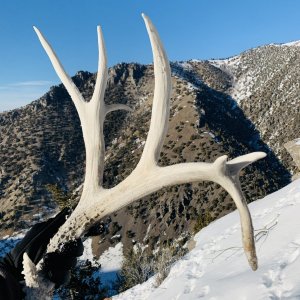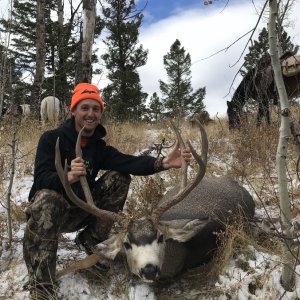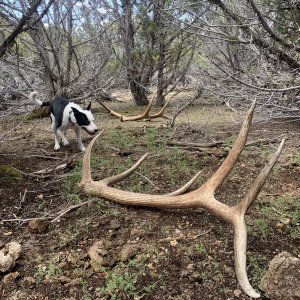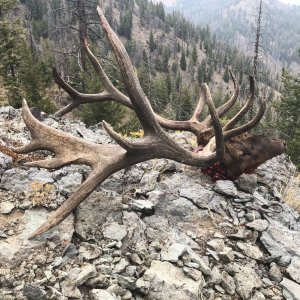You are using an out of date browser. It may not display this or other websites correctly.
You should upgrade or use an alternative browser.
You should upgrade or use an alternative browser.
Altitude Sickness
- Thread starter KingCrow
- Start date
T
TheGreatWhiteHunter
Guest
Drink lots of water
THE LORD IS MY ROCK
COLORADO,USA
NRA LIFE MEMBER
HUNTING PASS IT ON
THE LORD IS MY ROCK
COLORADO,USA
NRA LIFE MEMBER
HUNTING PASS IT ON
R
RACKMASTER
Guest
water and carbs...and don't smoke the wacky stuff...and try some aspirin!
rm
rm
D
_droptine_
Guest
Rolaids. I know it sounds weird, but take them when you start to have the headache and it will make it go away.
B
BomberBlackies
Guest
I've had excellent results with orange juice and lots of water.
Drink lots of water and try the WA altitude advantage
http://www.wildernessathlete.org/altitude_advantage.html
http://www.wildernessathlete.org/altitude_advantage.html
CAforkedhorn
Long Time Member
- Messages
- 3,529
go to your doctor and tell him you need a presciption for altitude sickness and most likely he will prescribe Decadron or Dexamethasone tablets. Before I discovered these babies I would get a massive headache and throw up every time I ventured up the hills. Now I just take them as prescribed and have no headaches and no side effects whatsoever.
swbuckmaster
Long Time Member
- Messages
- 5,004
I have never gotten altitude sickness but while I was in Peru we got up around 18,000-19,000 feet.
To help prepare for this altitude I was told to drink coca tea, and eat coca candy, and chew on coca leaves. I was also told to eat lots of chocolate before we got to the elevation where we could get sick.
Hiking around wasn?t two bad but when you tried to sleep at night or on the bus you would wake up like you were suffocating about every 5 min.
Archery is a year round commitment!!
To help prepare for this altitude I was told to drink coca tea, and eat coca candy, and chew on coca leaves. I was also told to eat lots of chocolate before we got to the elevation where we could get sick.
Hiking around wasn?t two bad but when you tried to sleep at night or on the bus you would wake up like you were suffocating about every 5 min.
Archery is a year round commitment!!
So......here comes the sales pitch.
I live at the foot of Mt.Whitney in the Eastern Sierra. I manage a sporting goods store...the largest in town. Something like 100 people a day hike this mountain. They come here thinking they can live at the beach, or Kansas City and hit 14,500 feet 2 days later. Flatlanders!!!
Altitude sickness turns fully 25% of them back.
About 10 years ago, I got a hold of this oil that you simply dab a drop behind your ears at the first sign of altitude sickness.....and you are good to go.
I HAVE NEVER HAD 1 CUSTOMER SAY IT DIDN'T WORK!!!
I actually used it myself on a boat trip out to Santa Cruz island and it prevented seasickness.......... I normally start hurlin' as soon as someone uses the words "boat" and "ocean" in same sentance.
The name of the stuff is; MOTION EAZE
made by:Alta Labs
Grand Rapids MI
phone# 888-212-5503
Hope this helps.
I live at the foot of Mt.Whitney in the Eastern Sierra. I manage a sporting goods store...the largest in town. Something like 100 people a day hike this mountain. They come here thinking they can live at the beach, or Kansas City and hit 14,500 feet 2 days later. Flatlanders!!!
Altitude sickness turns fully 25% of them back.
About 10 years ago, I got a hold of this oil that you simply dab a drop behind your ears at the first sign of altitude sickness.....and you are good to go.
I HAVE NEVER HAD 1 CUSTOMER SAY IT DIDN'T WORK!!!
I actually used it myself on a boat trip out to Santa Cruz island and it prevented seasickness.......... I normally start hurlin' as soon as someone uses the words "boat" and "ocean" in same sentance.
The name of the stuff is; MOTION EAZE
made by:Alta Labs
Grand Rapids MI
phone# 888-212-5503
Hope this helps.
OutdoorWriter
Long Time Member
- Messages
- 8,340
LAST EDITED ON Jul-06-08 AT 09:53AM (MST)[p]It works for motion sickness, but I'm not sure it will help with headaches, etc, caused by high altitude.
Here's the web site. -TONY
http://www.motioneaze.com/
Here's the web site. -TONY
http://www.motioneaze.com/
S
STIKSLINGR
Guest
I will attest to the Wilderness Athlete, Altitude Advantage!! Great product. I have always needed a couple days to aclimate. For the first time this year I tried it and "No problems" I will be sure I use it from here on out!
"I'm not sure it works for altitude sickness"
..........Hey, I'm not going to argue, just helping the guy out. You got a better test group than I do?
I live 300 miles from the ocean......we don't sell this stuff for motion sickness symptoms! We have this mountain, that is 10,500 feet higher than this store,and 14,500 feet higher than Los Angeles. Altitude sickness is no joke and this stuff works.
We have sold a gross of this product every year for 10 years now. The things that cause altitude sickness and the things that affect motion sickness are much the same in the body. I don't know all the details....but I AM sure it works for altitude sickness, otherwise I wouldn't have posted it.
..........Hey, I'm not going to argue, just helping the guy out. You got a better test group than I do?
I live 300 miles from the ocean......we don't sell this stuff for motion sickness symptoms! We have this mountain, that is 10,500 feet higher than this store,and 14,500 feet higher than Los Angeles. Altitude sickness is no joke and this stuff works.
We have sold a gross of this product every year for 10 years now. The things that cause altitude sickness and the things that affect motion sickness are much the same in the body. I don't know all the details....but I AM sure it works for altitude sickness, otherwise I wouldn't have posted it.
txhunter58
Long Time Member
- Messages
- 8,540
>go to your doctor and tell
>him you need a presciption
>for altitude sickness and most
>likely he will prescribe Decadron
>or Dexamethasone tablets. Before
>I discovered these babies I
>would get a massive headache
>and throw up every time
>I ventured up the hills.
> Now I just take
>them as prescribed and have
>no headaches and no side
>effects whatsoever.
I have never heard of using a corticosteroid (cortisone) for prevention of altitude sickness. Anyone else been prescribed this?
How do you take it and at what dosage?
One side effect if the dosage is high enough would be having to drink and pee more, but you already need to do that. And coritsone can make some people "jittery" and have insomnia, again depending on the dosage and how people react to the drug. And it certainly wouldn't be given to pregnant women.
Bottom line for me is that I have found supplements that works without a prescription: altitude adjustment and rolaids/tums.
txhunter58
venor, ergo sum (I hunt, therefore I am)
>him you need a presciption
>for altitude sickness and most
>likely he will prescribe Decadron
>or Dexamethasone tablets. Before
>I discovered these babies I
>would get a massive headache
>and throw up every time
>I ventured up the hills.
> Now I just take
>them as prescribed and have
>no headaches and no side
>effects whatsoever.
I have never heard of using a corticosteroid (cortisone) for prevention of altitude sickness. Anyone else been prescribed this?
How do you take it and at what dosage?
One side effect if the dosage is high enough would be having to drink and pee more, but you already need to do that. And coritsone can make some people "jittery" and have insomnia, again depending on the dosage and how people react to the drug. And it certainly wouldn't be given to pregnant women.
Bottom line for me is that I have found supplements that works without a prescription: altitude adjustment and rolaids/tums.
txhunter58
venor, ergo sum (I hunt, therefore I am)
AWHOLELOTTABULL
Long Time Member
- Messages
- 4,357
Just a couple of things to remember with Acute Mountain Sickness (aka "altitude sickness").
#1- most people think you have to be at extreme altitudes to
get Mountain Sickness. You don't. If you are a "flat
lander" and are used to living at 3000 ft or below, you
can start seeing the symptoms of Mountain Sickness at
5000-6000 ft.
If you live in mountainous terrain you can see signs of
Mountain Sickness as low as 8000 ft. Most of the more
critical symptoms surface at altitudes at 13,000 ft and
above.
#2- Altitude sickness is caused by a decrease in barometric
pressure and a decrease of oxygen in ambient air. The
higher you go the less oxygen content there is and the
less pressure in the air to force it into the lungs. The
headache people talk about is actually caused by the
swelling of the brain (cerebral edema). The difficulty
breathing you experience is caused by the swelling in the
lungs (pulmonary edema). Some people experience
blurred vision. This is caused by the swelling of the
retina and can actually result in retinal bleeding.
#3- If you experience any of the above symptoms the best way
to get rid of the symptoms is to descend immediately and
drink lots of water. You can take pain medication if you
need to, like tylenol or motrin but be very catious with
taking aspirin. It may increase your risk of retinal
bleeding.
#4- The best way to prevent Mountain Sickness is a gradual
climb over 48 hours (no more than 1000 feet per
day). Also (as several have mentioned), increasing water
intake and decreasing caffiene intake. You are doing the
preverbial "pissing in the wind" if you are drinking soft
drinks and coffee with caffiene in it.
#5- If you are prone to Mountain Sickness, the recommended
drug of choice is Acetazolamide (anticonvulsant) and the
next best drug is dexamethasone (corticosteroid). The
steroid should only be used during the time it takes to
acclimate (48-72 hours).
Sorry about the long post but I have experienced this myself and treated many patients with this. It is generally mild and can be fixed with simple rest and tylenol/motrin. It can also be life threatening. I hope this helps and is not too over the top.
It's always an adventure!!!
www.awholelottabull.com
#1- most people think you have to be at extreme altitudes to
get Mountain Sickness. You don't. If you are a "flat
lander" and are used to living at 3000 ft or below, you
can start seeing the symptoms of Mountain Sickness at
5000-6000 ft.
If you live in mountainous terrain you can see signs of
Mountain Sickness as low as 8000 ft. Most of the more
critical symptoms surface at altitudes at 13,000 ft and
above.
#2- Altitude sickness is caused by a decrease in barometric
pressure and a decrease of oxygen in ambient air. The
higher you go the less oxygen content there is and the
less pressure in the air to force it into the lungs. The
headache people talk about is actually caused by the
swelling of the brain (cerebral edema). The difficulty
breathing you experience is caused by the swelling in the
lungs (pulmonary edema). Some people experience
blurred vision. This is caused by the swelling of the
retina and can actually result in retinal bleeding.
#3- If you experience any of the above symptoms the best way
to get rid of the symptoms is to descend immediately and
drink lots of water. You can take pain medication if you
need to, like tylenol or motrin but be very catious with
taking aspirin. It may increase your risk of retinal
bleeding.
#4- The best way to prevent Mountain Sickness is a gradual
climb over 48 hours (no more than 1000 feet per
day). Also (as several have mentioned), increasing water
intake and decreasing caffiene intake. You are doing the
preverbial "pissing in the wind" if you are drinking soft
drinks and coffee with caffiene in it.
#5- If you are prone to Mountain Sickness, the recommended
drug of choice is Acetazolamide (anticonvulsant) and the
next best drug is dexamethasone (corticosteroid). The
steroid should only be used during the time it takes to
acclimate (48-72 hours).
Sorry about the long post but I have experienced this myself and treated many patients with this. It is generally mild and can be fixed with simple rest and tylenol/motrin. It can also be life threatening. I hope this helps and is not too over the top.
It's always an adventure!!!
www.awholelottabull.com
sjhgraysage
Very Active Member
- Messages
- 2,290
According to Craig Boddington the perscription drug for altitude sickness is "Diamox"
AWHOLELOTTABULL
Long Time Member
- Messages
- 4,357
Acetazolamide and Diamox are the same drug. Brand name vs Generic. He's right.
It's always an adventure!!!
www.awholelottabull.com
It's always an adventure!!!
www.awholelottabull.com
H
HKShooter
Guest
Just like AWLB said...
Altitude sickness, also known as acute mountain sickness (AMS), altitude illness, or soroche, is a pathological condition that is caused by acute exposure to low air pressure (usually outdoors at high altitudes). It commonly occurs above 2,400 metres (approximately 8,000 feet).[1] Acute mountain sickness can progress to high altitude pulmonary edema (HAPE) or high altitude cerebral edema (HACE).[2]
Altitude sickness is caused by reduced partial pressure of oxygen. The percentage of oxygen in air remains essentially constant with altitude at 21 percent, but the air pressure (and therefore the number of oxygen molecules) drops with altitude.[3] Altitude sickness usually does not affect persons traveling in aircraft because modern aircraft passenger compartments are pressurized.
A related condition,[citation needed] occurring only after prolonged exposure to high altitude, is chronic mountain sickness, also known as Monge's disease.
An unrelated condition, although often confused with altitude sickness, is dehydration, due to the higher rate of water vapor lost from the lungs at higher altitudes.
Contents [hide]
1 Introduction
2 Signs and symptoms
3 Severe cases
4 Prevention
4.1 Altitude acclimatization
4.2 Drugs
4.3 Oxygen enrichment
4.4 Other methods
5 Treatment
[edit] Introduction
High altitude or mountain sickness is defined when someone feels sick at high altitudes, such as in the mountains or any other altitude-related sicknesses. It is hard to determine who will be affected by altitude-sickness as there are no specific factors that compare with this susceptibility to altitude sickness. However, most people can climb up to 2500 meters (8000 feet) normally.
Generally, different people have different susceptibilities to altitude sickness. For some otherwise healthy people, Acute Mountain Sickness (AMS) can begin to appear at around 2000 meters (6,500 feet) above sea level, such as at many mountain ski resorts, equivalent to a pressure of 80 kPa. AMS is the most frequent type of altitude sickness encountered. Symptoms often manifest themselves 6-10 hours after ascent and generally subside in 1 to 2 days, but they occasionally develop into the more serious conditions. Symptoms include headache, fatigue, stomach illness, dizziness, and sleep disturbance. Exertion aggravates the symptoms.
High altitude pulmonary edema (HAPE) and cerebral edema (HACE) are the most ominous of these symptoms, while AMS, retinal hemorrhage, and peripheral edema are less severe forms of the disease. The rate of ascent, altitude attained, amount of physical activity at high altitude, as well as individual susceptibility, are contributing factors to the onset and severity of high-altitude illness.
Altitude sickness usually occurs following a rapid ascent and can usually be prevented by ascending slowly.[4] In most of these cases, the symptoms are temporary and usually abate as altitude acclimatisation occurs. However, in extreme cases, altitude sickness can be fatal.
The word "soroche" came from South America and originally meant "ore", because of an old, incorrect belief that it was caused by toxic emanations of ores in the Andes mountains. [1]
[edit] Signs and symptoms
This sign near the peak of Mount Evans (elev. 14264 ft or 4,350 meters) in Colorado, USA, warns of altitude sickness symptoms.Headache is a primary symptom used to diagnose altitude sickness, although headache is also a symptom of dehydration. A headache occurring at an altitude above 2,400 meters (8000 feet = 76 kPa), combined with any one or more of the following symptoms, can indicate altitude sickness:
Lack of appetite, nausea, or vomiting
Fatigue or weakness
Dizziness or light-headedness
Insomnia
Pins and needles
Shortness of breath upon exertion
Persistent rapid pulse
Drowsiness
General malaise
Peripheral edema (swelling of hands, feet, and face).
Symptoms that may indicate life-threatening altitude sickness include:
pulmonary edema (fluid in the lungs):-
persistent dry cough
fever
shortness of breath even when resting
cerebral edema (swelling of the brain):-
headache that does not respond to analgesics
unsteady gait
increased vomiting
gradual loss of consciousness.
[edit] Severe cases
The most serious symptoms of altitude sickness are due to edema (fluid accumulation in the tissues of the body). At very high altitude, humans can get either high altitude pulmonary edema (HAPE), or high altitude cerebral edema (HACE). The physiological cause of altitude-induced edema is not conclusively established. It is currently believed, however, that HACE is caused by local vasodilation of cerebral blood vessels in response to hypoxia, resulting in greater blood flow and, consequently, greater capillary pressures. On the other hand, HAPE may be due to general vasoconstriction in the pulmonary circulation (normally a response to regional ventilation-perfusion mismatches) which, with constant or increased cardiac output, also leads to increases in capillary pressures. For those suffering HACE, dexamethasone may provide temporary relief from symptoms in order to keep descending under their own power.
HAPE occurs in ~2% of those who are adjusting to altitudes of ~3000 m (10,000 feet = 70 kPa) or more. It can progress rapidly and is often fatal. Symptoms include fatigue, severe dyspnea at rest, and cough that is initially dry but may progress to produce pink, frothy sputum. Descent to lower altitudes alleviates the symptoms of HAPE.
HACE is a life threatening condition that can lead to coma or death. It occurs in about 1% of people adjusting to altitudes above ~2700 m (9,000 feet = 73 kPa). Symptoms include headache, fatigue, visual impairment, bladder dysfunction, bowel dysfunction, loss of coordination, paralysis on one side of the body, and confusion. Descent to lower altitudes may save those afflicted with HACE.
[edit] Prevention
[edit] Altitude acclimatization
Altitude acclimatisation is the process of adjusting to decreasing oxygen levels at higher elevations, in order to avoid altitude sickness. Once above approximately 3,000 meters (10,000 feet = 70 kPa), most climbers and high altitude trekkers follow the "golden rule" - climb high, sleep low. For high altitude climbers, a typical acclimatization regime might be to stay a few days at a base camp, climb up to a higher camp (slowly), then return to base camp. A subsequent climb to the higher camp would then include an overnight stay. This process is then repeated a few times, each time extending the time spent at higher altitudes to let the body "get used" to the oxygen level there, a process that involves the production of additional red blood cells. Once the climber has acclimatised to a given altitude, the process is repeated with camps placed at progressively higher elevations. The general rule of thumb is to not ascend more than 300 metres (1,000 feet) per day to sleep. That is, one can climb from 3,000 (10,000 feet = 70 kPa) to 4,500 metres (15,000 feet = 58 kPa) in one day, but one should then descend back to 3,300 metres (11,000 feet = 67.5 kPa) to sleep. This process cannot safely be rushed, and this explains why climbers need to spend days (or even weeks at times) acclimatising before attempting to climb a high peak. Simulated altitude equipment that produce hypoxic (reduced oxygen) air can be used to acclimate to altitude, reducing the total time required on the mountain itself.
[edit] Drugs
Acetazolamide may help some people to speed up the acclimatisation process, and can treat mild cases of altitude sickness.
A single randomized controlled trial found that sumatriptan may help prevent altitude sickness.[5]
For centuries, indigenous cultures of the Altiplano, such as the Aymaras, have used coca leaves to treat mild altitude sickness.
[edit] Oxygen enrichment
In high-altitude conditions, oxygen enrichment can counteract the effects of altitude sickness, or hypoxia. A small amount of supplemental oxygen reduces the equivalent altitude in climate-controlled rooms. At 3,400 m (67 kPa), raising the oxygen concentration level by 5 percent via an oxygen concentrator and an existing ventilation system provides an effective altitude of 3,000 m (70 kPa), which is more tolerable for surface-dwellers.[6] The most effective source of supplemental oxygen at high altitude are oxygen concentrators that use vacuum swing adsorption (VSA) technology.[neutrality disputed] As opposed to generators that use pressure swing adsorption (PSA), VSA technology does not suffer from performance degradation at increased altitude. The lower air density actually facilitates the vacuum step process.
[edit] Other methods
Drinking plenty of water will also help in acclimatisation[7] to replace the fluids lost through heavier breathing in the thin, dry air found at altitude, although consuming excessive quantities ("over-hydration") has no benefits and may lead to hyponatremia.
Oxygen from gas bottles or liquid containers can be applied directly via a nasal cannula or mask. Oxygen concentrators based upon PSA, VSA, or VPSA can be used to generate the oxygen if electricity is available. Stationary oxygen concentrators typically use PSA technology, which has performance degradations at the lower barometric pressures at high altitudes. One way to compensate for the performance degradation is to utilize a concentrator with more flow capacity. There are also portable oxygen concentrators that can be used on vehicle DC power or on internal batteries, and at least one system commercially available measures and compensates for the altitude effect on its performance up to 4,000 meters (13,123 feet). The application of high-purity oxygen from one of these methods increases the partial pressure of oxygen by raising the FIO2 (fraction of inspired oxygen).
[edit] Treatment
The only real cure once symptoms appear is for the sufferer to move to a lower altitude as quickly as possible.
For serious cases of AMS, a Gamow bag can be used to reduce the effective altitude by as much as 1,500 meters (5,000 feet). A Gamow bag is a portable plastic pressure bag inflated with a foot pump.
Acetazolamide may treat mild cases of altitude sickness.[8][9]
Patients can sometimes control mild altitude sickness by consciously taking 10-12 large, rapid breaths every 5 minutes.[citation needed] If overdone, this can remove too much carbon dioxide and cause tingling in the extremities of the body.
The folk remedy for altitude sickness in Peru and Bolivia is a tea made from the coca plant. See mate de coca.
Other treatments include injectable steroids to reduce pulmonary edema, and inflatable pressure vessels to relieve and evacuate severe mountain-sick persons.
See also
Mountain climbing
Cabin pressurization
Secondary polycythemia
Altitude training
High altitude pulmonary edema
High altitude cerebral edema
Don't think it won't affect you. It will pick who it wants to and those headaches don't go away. It doesn't matter if you're the best athelete in the world or the fatest slob in the world, you never know who it will affect. I got it last year and will definately try out the recomendations found above.
HK
GO HARD KORE AND HUNT ABOVE 11,000
Altitude sickness, also known as acute mountain sickness (AMS), altitude illness, or soroche, is a pathological condition that is caused by acute exposure to low air pressure (usually outdoors at high altitudes). It commonly occurs above 2,400 metres (approximately 8,000 feet).[1] Acute mountain sickness can progress to high altitude pulmonary edema (HAPE) or high altitude cerebral edema (HACE).[2]
Altitude sickness is caused by reduced partial pressure of oxygen. The percentage of oxygen in air remains essentially constant with altitude at 21 percent, but the air pressure (and therefore the number of oxygen molecules) drops with altitude.[3] Altitude sickness usually does not affect persons traveling in aircraft because modern aircraft passenger compartments are pressurized.
A related condition,[citation needed] occurring only after prolonged exposure to high altitude, is chronic mountain sickness, also known as Monge's disease.
An unrelated condition, although often confused with altitude sickness, is dehydration, due to the higher rate of water vapor lost from the lungs at higher altitudes.
Contents [hide]
1 Introduction
2 Signs and symptoms
3 Severe cases
4 Prevention
4.1 Altitude acclimatization
4.2 Drugs
4.3 Oxygen enrichment
4.4 Other methods
5 Treatment
[edit] Introduction
High altitude or mountain sickness is defined when someone feels sick at high altitudes, such as in the mountains or any other altitude-related sicknesses. It is hard to determine who will be affected by altitude-sickness as there are no specific factors that compare with this susceptibility to altitude sickness. However, most people can climb up to 2500 meters (8000 feet) normally.
Generally, different people have different susceptibilities to altitude sickness. For some otherwise healthy people, Acute Mountain Sickness (AMS) can begin to appear at around 2000 meters (6,500 feet) above sea level, such as at many mountain ski resorts, equivalent to a pressure of 80 kPa. AMS is the most frequent type of altitude sickness encountered. Symptoms often manifest themselves 6-10 hours after ascent and generally subside in 1 to 2 days, but they occasionally develop into the more serious conditions. Symptoms include headache, fatigue, stomach illness, dizziness, and sleep disturbance. Exertion aggravates the symptoms.
High altitude pulmonary edema (HAPE) and cerebral edema (HACE) are the most ominous of these symptoms, while AMS, retinal hemorrhage, and peripheral edema are less severe forms of the disease. The rate of ascent, altitude attained, amount of physical activity at high altitude, as well as individual susceptibility, are contributing factors to the onset and severity of high-altitude illness.
Altitude sickness usually occurs following a rapid ascent and can usually be prevented by ascending slowly.[4] In most of these cases, the symptoms are temporary and usually abate as altitude acclimatisation occurs. However, in extreme cases, altitude sickness can be fatal.
The word "soroche" came from South America and originally meant "ore", because of an old, incorrect belief that it was caused by toxic emanations of ores in the Andes mountains. [1]
[edit] Signs and symptoms
This sign near the peak of Mount Evans (elev. 14264 ft or 4,350 meters) in Colorado, USA, warns of altitude sickness symptoms.Headache is a primary symptom used to diagnose altitude sickness, although headache is also a symptom of dehydration. A headache occurring at an altitude above 2,400 meters (8000 feet = 76 kPa), combined with any one or more of the following symptoms, can indicate altitude sickness:
Lack of appetite, nausea, or vomiting
Fatigue or weakness
Dizziness or light-headedness
Insomnia
Pins and needles
Shortness of breath upon exertion
Persistent rapid pulse
Drowsiness
General malaise
Peripheral edema (swelling of hands, feet, and face).
Symptoms that may indicate life-threatening altitude sickness include:
pulmonary edema (fluid in the lungs):-
persistent dry cough
fever
shortness of breath even when resting
cerebral edema (swelling of the brain):-
headache that does not respond to analgesics
unsteady gait
increased vomiting
gradual loss of consciousness.
[edit] Severe cases
The most serious symptoms of altitude sickness are due to edema (fluid accumulation in the tissues of the body). At very high altitude, humans can get either high altitude pulmonary edema (HAPE), or high altitude cerebral edema (HACE). The physiological cause of altitude-induced edema is not conclusively established. It is currently believed, however, that HACE is caused by local vasodilation of cerebral blood vessels in response to hypoxia, resulting in greater blood flow and, consequently, greater capillary pressures. On the other hand, HAPE may be due to general vasoconstriction in the pulmonary circulation (normally a response to regional ventilation-perfusion mismatches) which, with constant or increased cardiac output, also leads to increases in capillary pressures. For those suffering HACE, dexamethasone may provide temporary relief from symptoms in order to keep descending under their own power.
HAPE occurs in ~2% of those who are adjusting to altitudes of ~3000 m (10,000 feet = 70 kPa) or more. It can progress rapidly and is often fatal. Symptoms include fatigue, severe dyspnea at rest, and cough that is initially dry but may progress to produce pink, frothy sputum. Descent to lower altitudes alleviates the symptoms of HAPE.
HACE is a life threatening condition that can lead to coma or death. It occurs in about 1% of people adjusting to altitudes above ~2700 m (9,000 feet = 73 kPa). Symptoms include headache, fatigue, visual impairment, bladder dysfunction, bowel dysfunction, loss of coordination, paralysis on one side of the body, and confusion. Descent to lower altitudes may save those afflicted with HACE.
[edit] Prevention
[edit] Altitude acclimatization
Altitude acclimatisation is the process of adjusting to decreasing oxygen levels at higher elevations, in order to avoid altitude sickness. Once above approximately 3,000 meters (10,000 feet = 70 kPa), most climbers and high altitude trekkers follow the "golden rule" - climb high, sleep low. For high altitude climbers, a typical acclimatization regime might be to stay a few days at a base camp, climb up to a higher camp (slowly), then return to base camp. A subsequent climb to the higher camp would then include an overnight stay. This process is then repeated a few times, each time extending the time spent at higher altitudes to let the body "get used" to the oxygen level there, a process that involves the production of additional red blood cells. Once the climber has acclimatised to a given altitude, the process is repeated with camps placed at progressively higher elevations. The general rule of thumb is to not ascend more than 300 metres (1,000 feet) per day to sleep. That is, one can climb from 3,000 (10,000 feet = 70 kPa) to 4,500 metres (15,000 feet = 58 kPa) in one day, but one should then descend back to 3,300 metres (11,000 feet = 67.5 kPa) to sleep. This process cannot safely be rushed, and this explains why climbers need to spend days (or even weeks at times) acclimatising before attempting to climb a high peak. Simulated altitude equipment that produce hypoxic (reduced oxygen) air can be used to acclimate to altitude, reducing the total time required on the mountain itself.
[edit] Drugs
Acetazolamide may help some people to speed up the acclimatisation process, and can treat mild cases of altitude sickness.
A single randomized controlled trial found that sumatriptan may help prevent altitude sickness.[5]
For centuries, indigenous cultures of the Altiplano, such as the Aymaras, have used coca leaves to treat mild altitude sickness.
[edit] Oxygen enrichment
In high-altitude conditions, oxygen enrichment can counteract the effects of altitude sickness, or hypoxia. A small amount of supplemental oxygen reduces the equivalent altitude in climate-controlled rooms. At 3,400 m (67 kPa), raising the oxygen concentration level by 5 percent via an oxygen concentrator and an existing ventilation system provides an effective altitude of 3,000 m (70 kPa), which is more tolerable for surface-dwellers.[6] The most effective source of supplemental oxygen at high altitude are oxygen concentrators that use vacuum swing adsorption (VSA) technology.[neutrality disputed] As opposed to generators that use pressure swing adsorption (PSA), VSA technology does not suffer from performance degradation at increased altitude. The lower air density actually facilitates the vacuum step process.
[edit] Other methods
Drinking plenty of water will also help in acclimatisation[7] to replace the fluids lost through heavier breathing in the thin, dry air found at altitude, although consuming excessive quantities ("over-hydration") has no benefits and may lead to hyponatremia.
Oxygen from gas bottles or liquid containers can be applied directly via a nasal cannula or mask. Oxygen concentrators based upon PSA, VSA, or VPSA can be used to generate the oxygen if electricity is available. Stationary oxygen concentrators typically use PSA technology, which has performance degradations at the lower barometric pressures at high altitudes. One way to compensate for the performance degradation is to utilize a concentrator with more flow capacity. There are also portable oxygen concentrators that can be used on vehicle DC power or on internal batteries, and at least one system commercially available measures and compensates for the altitude effect on its performance up to 4,000 meters (13,123 feet). The application of high-purity oxygen from one of these methods increases the partial pressure of oxygen by raising the FIO2 (fraction of inspired oxygen).
[edit] Treatment
The only real cure once symptoms appear is for the sufferer to move to a lower altitude as quickly as possible.
For serious cases of AMS, a Gamow bag can be used to reduce the effective altitude by as much as 1,500 meters (5,000 feet). A Gamow bag is a portable plastic pressure bag inflated with a foot pump.
Acetazolamide may treat mild cases of altitude sickness.[8][9]
Patients can sometimes control mild altitude sickness by consciously taking 10-12 large, rapid breaths every 5 minutes.[citation needed] If overdone, this can remove too much carbon dioxide and cause tingling in the extremities of the body.
The folk remedy for altitude sickness in Peru and Bolivia is a tea made from the coca plant. See mate de coca.
Other treatments include injectable steroids to reduce pulmonary edema, and inflatable pressure vessels to relieve and evacuate severe mountain-sick persons.
See also
Mountain climbing
Cabin pressurization
Secondary polycythemia
Altitude training
High altitude pulmonary edema
High altitude cerebral edema
Don't think it won't affect you. It will pick who it wants to and those headaches don't go away. It doesn't matter if you're the best athelete in the world or the fatest slob in the world, you never know who it will affect. I got it last year and will definately try out the recomendations found above.
HK
GO HARD KORE AND HUNT ABOVE 11,000
cheeseheadinOHIO
Active Member
- Messages
- 490
I have to SECOND the ROLAIDS. My guide in MT told me about them and have used them and they work. Throw a roll in the pack. Prevents ruining a day.
CAelknuts
Moderator
- Messages
- 3,822
There is some great information in this thread. The main things I've always heard, Diamox, Rolaids, good hydration and going lower if serious symptoms present, have all been offered. I have one more to offer, though I've never tried it.
My employer is an adventure racer. For those not familiar with adventure racing, it is the most extreme sport out there. He just finished a race about a week ago that was in Montana, it took his team 7 days to cover the 500+ mile course, much of which was over 10,000 feet altitude. They hike, bike, run, kayak, swim, climb, rappel, abseil, river board, paddle canoes or rafts all along some extreme wilderness courses. Just before he left on the Montana race (some of his other races have been in New Zealand, South Africa, Yukon, Sweden, Colorado, Fiji, Utah, Costa Rica) we got to talking about altitude sickness prevention. I mentioned Diamox and Rolaids. He told me that the new hot drug that some adventure racers are using for prevention of altitude sickness is........VIAGRA! Believe me, on an adventure race, the last thing any racer would care about is taking advantage of the other side effect this drug has. They just want to survive.
My employer is an adventure racer. For those not familiar with adventure racing, it is the most extreme sport out there. He just finished a race about a week ago that was in Montana, it took his team 7 days to cover the 500+ mile course, much of which was over 10,000 feet altitude. They hike, bike, run, kayak, swim, climb, rappel, abseil, river board, paddle canoes or rafts all along some extreme wilderness courses. Just before he left on the Montana race (some of his other races have been in New Zealand, South Africa, Yukon, Sweden, Colorado, Fiji, Utah, Costa Rica) we got to talking about altitude sickness prevention. I mentioned Diamox and Rolaids. He told me that the new hot drug that some adventure racers are using for prevention of altitude sickness is........VIAGRA! Believe me, on an adventure race, the last thing any racer would care about is taking advantage of the other side effect this drug has. They just want to survive.
M
megalomaniac
Guest
I'm a big fan of Dexamethasone in small doses.
My first hunt was back in 2005, and after 4 or 5 hours at 12,000-13,000 ft, I started getting the headache. It went away when I got back to camp at 10,000 ft.
I've also got a bum knee, and the second day of the hunt I was almost unable to walk at all due to swelling of the knee. Fortunately, Katrina hit that Monday, and I had to load up and leave the woods to get back to south Mississippi.
The following year, and in years since, I've started on a cocktail of 4mg Dexamethasone daily, 200mg Celebrex daily, and Nexium. I've been able to hike like a machine with no effects of altitude. Plus, the Dexamethasone helps prevent swelling in the knee, so I've had no trouble with it either. And I usually go 4-7 miles daily in some rough terrain.
The celebrex is a potent antiinflammatory agent, also helps with the knee. The Nexium is an acid blocker for the stomach so I won't get an ulcer from the steroids and antiinflammatories- sort of a preventative.
Diamox is supposed to work for the altitude, but I've never tried it.
Many have accused me of using 'performance enhancing drugs' for my hunts... the way I look at it, this is not the 'tour de france'. If it keeps me in the woods for the whole week instead of feeling miserable, it's more than worth it!
My first hunt was back in 2005, and after 4 or 5 hours at 12,000-13,000 ft, I started getting the headache. It went away when I got back to camp at 10,000 ft.
I've also got a bum knee, and the second day of the hunt I was almost unable to walk at all due to swelling of the knee. Fortunately, Katrina hit that Monday, and I had to load up and leave the woods to get back to south Mississippi.
The following year, and in years since, I've started on a cocktail of 4mg Dexamethasone daily, 200mg Celebrex daily, and Nexium. I've been able to hike like a machine with no effects of altitude. Plus, the Dexamethasone helps prevent swelling in the knee, so I've had no trouble with it either. And I usually go 4-7 miles daily in some rough terrain.
The celebrex is a potent antiinflammatory agent, also helps with the knee. The Nexium is an acid blocker for the stomach so I won't get an ulcer from the steroids and antiinflammatories- sort of a preventative.
Diamox is supposed to work for the altitude, but I've never tried it.
Many have accused me of using 'performance enhancing drugs' for my hunts... the way I look at it, this is not the 'tour de france'. If it keeps me in the woods for the whole week instead of feeling miserable, it's more than worth it!
O
Oakbuck
Guest
>About 10 years ago, I got
>a hold of this oil
>that you simply dab a
>drop behind your ears at
>the first sign of altitude
>sickness.....and you are good to
>go.
>
>I HAVE NEVER HAD 1 CUSTOMER
>SAY IT DIDN'T WORK!!!
Thanks for the tip Nickman. My 10 year old son and I are headed to SW Colorado to climb some 14ers (Handies, Redcloud and Sunshine peaks) in a couple of weeks. I'll give it a try.
Oakbuck
>a hold of this oil
>that you simply dab a
>drop behind your ears at
>the first sign of altitude
>sickness.....and you are good to
>go.
>
>I HAVE NEVER HAD 1 CUSTOMER
>SAY IT DIDN'T WORK!!!
Thanks for the tip Nickman. My 10 year old son and I are headed to SW Colorado to climb some 14ers (Handies, Redcloud and Sunshine peaks) in a couple of weeks. I'll give it a try.
Oakbuck
Similar threads
- Replies
- 0
- Views
- 270












